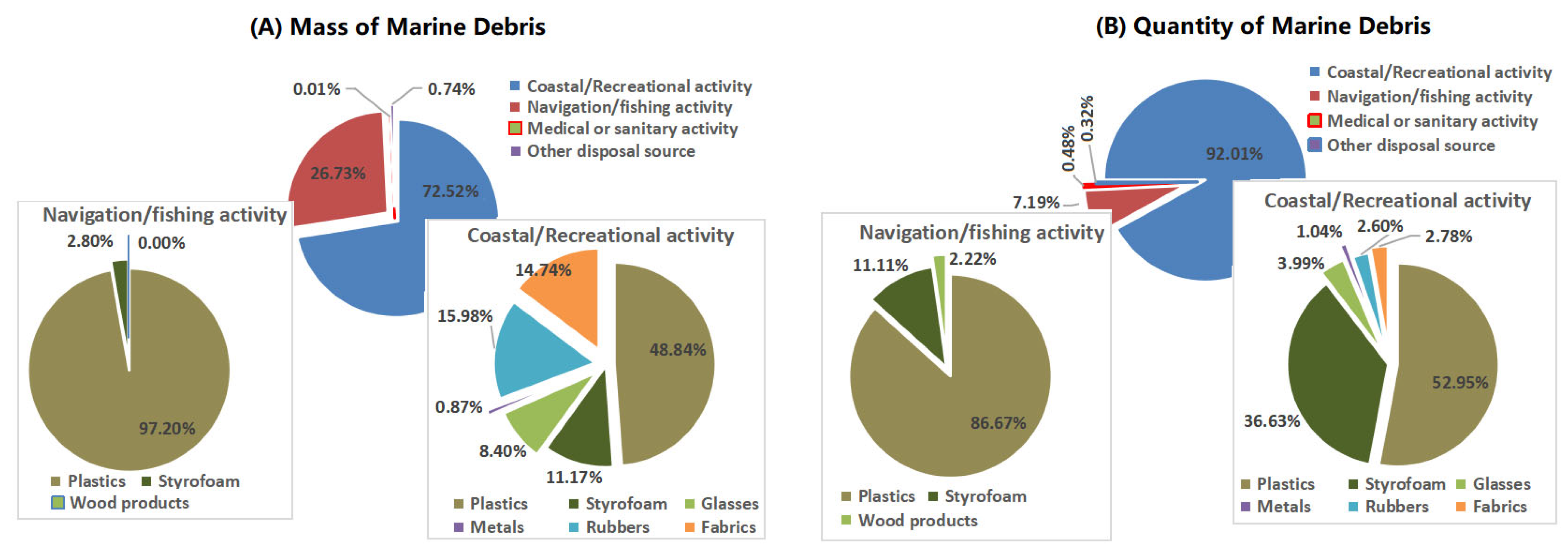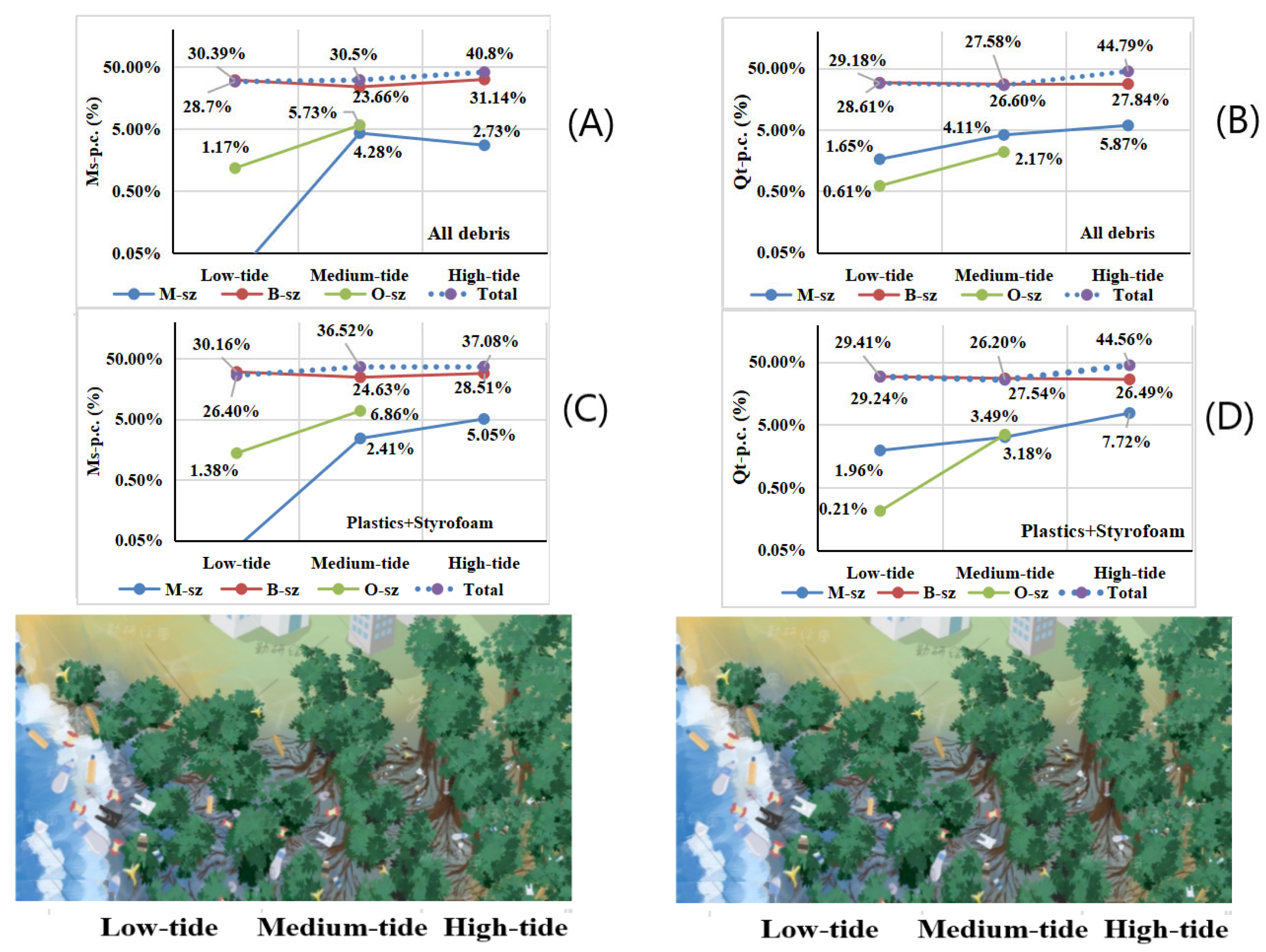Mapping and Potential Risk Assessment of Marine Debris in Mangrove Wetlands in the Northern South China Sea
Abstract
1. Introduction
2. Materials and Methods
2.1. Sampling and Field Analysis
2.2. Data Statistics and Potential Risk Assessment
3. Results
4. Discussion
4.1. Source of Marine Debris in the MNSCS
4.2. Spatial Distribution of Various-Sized Debris Items and Tidal Influence
4.3. Potential Risk Assessment
5. Conclusions
Supplementary Materials
Author Contributions
Funding
Data Availability Statement
Acknowledgments
Conflicts of Interest
Correction Statement
References
- Rovai, A.S.; Twilley, R.R.; Castañeda-Moya, E.; Riul, P.; Cifuentes-Jara, M.; Manrow-Villalobos, M.; Horta, P.A.; Simonassi, J.C.; Fonseca, A.L.; Pagliosa, P.R. Global controls on carbon storage in mangrove soils. Nat. Clim. Change 2018, 8, 534–538. [Google Scholar] [CrossRef]
- Li, D.; Zhao, L.; Guo, Z.; Yang, X.; Deng, W.; Zhong, H.; Zhou, P. Marine Debris in the Beilun Estuary Mangrove Forest: Monitoring, Assessment and Implications. Int. J. Environ. Res. Public Health 2021, 18, 10826. [Google Scholar] [CrossRef]
- Bunting, P.; Rosenqvist, A.; Lucas, R.M.; Rebelo, L.M.; Hilarides, L.; Thomas, N.; Hardy, A.; Itoh, T.; Shimada, M.; Finlayson, C.M. The Global Mangrove Watch—A New 2010 Global Baseline of Mangrove Extent. Remote Sens. 2018, 10, 1669. [Google Scholar] [CrossRef]
- Donato, D.C.; Kauffman, J.B.; Murdiyarso, D.; Kurnianto, S.; Stidham, M.; Kanninen, M. Mangroves among the most carbon-rich forests in the tropics. Nat. Geosci. 2011, 4, 293–297. [Google Scholar] [CrossRef]
- Costa, M.F.; Silva-Cavalcanti, J.S.; Barbosa, C.C.; Portugal, J.L.; Barletta, M. Plastics buried in the inter-tidal plain of a tropical estuarine ecosystem. J. Coast. Res. 2011, S64, 339–343. [Google Scholar]
- Martin, C.; Almahasheer, H.; Duarte, C.M. Mangrove forests as traps for marine litter. Environ. Pollut. 2019, 247, 499–508. [Google Scholar] [CrossRef]
- Martin, C.; Baalkhuyur, F.; Valluzzi, L.; Saderne, V.; Cusack, M.; Almahasheer, H.; Krishnakumar, P.K.; Rabaoui, L.; Qurban, M.; Arias-Ortiz, A.; et al. Exponential increase of plastic burial in mangrove sediments as a major plastic sink. Sci. Adv. 2020, 6, eaaz5593. [Google Scholar] [CrossRef]
- Riascos, J.M.; Valencia, N.; Peña, E.J.; Cantera, J.R. Inhabiting the technosphere: The encroachment of anthropogenic marine litter in Neotropical mangrove forests and its use as habitat by macrobenthic biota. Mar. Pollut. Bull. 2019, 142, 559–568. [Google Scholar] [CrossRef]
- Not, C.; Lui, C.Y.I.; Cannicci, S. Feeding behavior is the main driver for microparticle intake in mangrove crabs. Limnol. Oceanogr. Lett. 2020, 5, 84–91. [Google Scholar] [CrossRef]
- Luo, Y.Y.; Vorsatz, L.D.; Not, C.; Cannicci, S. Landward zones of mangroves are sinks for both land and water borne anthropogenic debris. Sci. Total Environ. 2021, 818, 151809. [Google Scholar] [CrossRef]
- Adyel, T.M.; Macreadie, P.I. World’s Largest Mangrove Forest Becoming Plastic Cesspit. Front. Mar. Sci. 2021, 8, 766876. [Google Scholar] [CrossRef]
- UNEP (United Nations Environment Programme). Marine Plastic Debris and Microplastics-Global Lessons and Research to Inspire Action and Guide Policy Change; United Nations Environment Programme (UNEP): Nairobi, Kenya, 2016; 252p. [Google Scholar]
- GESAMP. Guidelines or the Monitoring and Assessment of Plastic Litter and Microplastics in the Ocean; Kershaw, P.J., Turra, A., Galgani, F., Eds.; (IMO/FAO/UNESCO-IOC/NIDO/WMO/IAEA/UN/UNEP/UNDP/ISA Joint Group of Experts on the Scientific Aspects of Marine Environmental Protection). Rep. Stud. GESAMP No. 99; GESAMP: London, UK, 2019; p. 130. [Google Scholar]
- Roman, L.; Hardesty, B.D.; Leonard, G.H.; Pragnell-Raasch, H.; Mallos, N.; Campbell, I.; Wilcox, C. A global assessment of the relationship between anthropogenic debris on land and the seafloor. Environ. Pollut. 2020, 264, 114663. [Google Scholar] [CrossRef] [PubMed]
- Zhou, P.; Huang, C.; Fang, H.; Cai, X.; Li, D.; Li, H.; Yu, H. The abundance, composition and sources of marine debris in coastal seawaters or beaches around the northern South China Sea (China). Mar. Pollut. Bull. 2011, 62, 1998–2007. [Google Scholar] [CrossRef] [PubMed]
- Santos, R.G.; Machovsky-Capuska, G.E.; Andrades, R. Plastic ingestion as an evolutionary trap: Toward a holistic understanding. Science 2021, 373, 56–60. [Google Scholar] [CrossRef]
- MacLeod, M.; Arp, H.P.H.; Tekman, M.B.; Jahnke, A. The global threat from plastic pollution. Science 2021, 373, 61–65. [Google Scholar] [CrossRef]
- Cózar, A.; Echevarría, F.; González-Gordillo, J.I.; Irigoien, X.; Úbeda, B.; Hernández-León, S.; Palma, Á.T.; Navarro, S.; García-De-Lomas, J.; Ruiz, A.; et al. Plastic debris in the open ocean. Proc. Natl. Acad. Sci. USA 2014, 111, 10239–10244. [Google Scholar] [CrossRef]
- Debrot, A.O.; Meesters, H.W.G.; Bron, P.S.; De Leon, R. Marine debris in mangroves and on the seabed: Largely-neglected litter problems. Mar. Pollut. Bull. 2013, 72, 1. [Google Scholar] [CrossRef]
- Lebreton, L.C.M.; van der Zwet, J.; Damsteeg, J.-W.; Slat, B.; Andrady, A.; Reisser, J. River plastic emissions to the world’s oceans. Nat. Commun. 2017, 8, 15611. [Google Scholar] [CrossRef]
- Luo, Y.Y.; Not, C.; Cannicci, S. Mangroves as unique but understudied traps for anthropogenic marine debris: A review of present information and the way forward. Environ. Pollut. 2021, 271, 116291. [Google Scholar] [CrossRef]
- Nor, N.H.M.; Obbard, J.P. Microplastics in Singapore’s coastal mangrove ecosystems. Mar. Pollut. Bull. 2014, 79, 278–283. [Google Scholar] [CrossRef]
- Dan, X.; Liao, B.; Wu, Z.; Wu, H.; Bao, D.; Dan, W.; Liu, S. Resources, Conservation Status and Main Threats of Mangrove Wetlands in China. Ecol. Environ. Sci. 2016, 25, 1237–1243, (In Chinese with English Abstract). [Google Scholar] [CrossRef]
- Zhou, Q.; Tu, C.; Fu, C.; Li, Y.; Zhang, H.; Xiong, K.; Zhao, X.; Li, L.; Waniek, J.J.; Luo, Y. Characteristics and distribution of microplastics in the coastal mangrove sediments of China. Sci. Total Environ. 2020, 703, 134807. [Google Scholar] [CrossRef] [PubMed]
- do Sul, J.A.I.; Costa, M.F.; Silva-Cavalcanti, J.S.; Araújo, M.C.B. Plastic debris retention and exportation by a mangrove forest patch. Mar. Pollut. Bull. 2014, 78, 252–257. [Google Scholar] [CrossRef]
- Feller, I.C.; Lovelock, C.E.; Berger, U.; McKee, K.L.; Joye, S.B.; Ball, M.C. Biocomplexity in mangrove ecosystems. Annu. Rev. Mar. Sci. 2010, 2, 395–417. [Google Scholar] [CrossRef]
- Dahdouh-Guebas, F.; Jayatissa, L.P.; Di Nitto, D.; Bosire, J.O.; Lo Seen, D.; Koedam, N. How effective were mangroves as a defence against the recent tsunami? Curr. Biol. 2005, 15, R443–R447. [Google Scholar]
- Lima, A.R.A.; Barletta, M.; Costa, M.F.; Ramos, J.A.A.; Dantas, D.V.; Melo, P.A.M.C.; Justino, A.K.S.; Ferreira, G.V.B. Changes in the composition of ichthyoplankton assemblage and plastic debris in mangrove creeks relative to moon phases. J. Fish Biol. 2016, 89, 619–640. [Google Scholar] [CrossRef]
- Chee, S.Y.; Chai, Y.E.E.J.; Danielle, C.; Yusri, Y.; Barry, J. Anthropogenic marine debris accumulation in mangroves on Penang island, Malaysia. J. Sustain. Sci. Manag. 2020, 15, 41–67. [Google Scholar] [CrossRef]
- Deng, J.; Guo, P.; Zhang, X.; Su, H.; Zhang, Y.; Wu, Y.; Li, Y. Microplastics and accumulated heavy metals in restored mangrove wetland surface sediments at Jinjiang Estuary (Fujian, China). Mar. Pollut. Bull. 2020, 159, 111482. [Google Scholar] [CrossRef]
- Seeruttun, L.D.; Raghbor, P.; Appadoo, C. First assessment of anthropogenic marine debris in mangrove forests of Mauritius, a small oceanic island. Mar. Pollut. Bull. 2021, 164, 112019. [Google Scholar] [CrossRef]
- Srikanth, S.; Lum, S.K.Y.; Chen, Z. Mangrove root: Adaptations and ecological importance. Trees 2015, 30, 451–465. [Google Scholar] [CrossRef]
- Sandilyan, S.; Kathiresan, K. Plastic- a formidable threat to unique biodiversity of Pichavaram mangroves. Curr. Sci. 2012, 103, 1262–1263. [Google Scholar]
- Duan, J.; Han, J.; Cheung, S.G.; Chong, R.K.Y.; Lo, C.-M.; Lee, F.W.-F.; Xu, S.J.-L.; Yang, Y.; Tam, N.F.-Y.; Zhou, H.-C. How mangrove plants affect microplastic distribution in sediments of coastal wetlands: Case study in Shenzhen Bay, South China. Sci. Total Environ. 2021, 767, 144695. [Google Scholar] [CrossRef] [PubMed]
- Cordeiro, C.A.M.M.; Cózar, T.M. Evaluation of solid residues removed from a mangrove swamp in the Sao Vicente Estuary, SP, Brazil. Mar. Pollut. Bull. 2010, 60, 1762–1767. [Google Scholar] [CrossRef] [PubMed]
- Vermeiren, P.; Muñoz, C.C.; Ikejima, K. Sources and sinks of plastic debris in estuaries: A conceptual model integrating biological, physical and chemical distribution mechanisms. Mar. Pollut. Bull. 2016, 113, 7–16. [Google Scholar] [CrossRef]
- Gorman, D.; Turra, A. The role of mangrove revegetation as a means of restoring macrofaunal communities along degraded coasts. Sci. Total Environ. 2016, 566, 223–229. [Google Scholar] [CrossRef]
- Smith, S.D. Marine debris: A proximate threat to marine sustainability in Bootless Bay, Papua New Guinea. Mar. Pollut. Bull. 2012, 64, 1880–1883. [Google Scholar] [CrossRef]
- van Bijsterveldt, C.E.; van Wesenbeeck, B.K.; Ramadhani, S.; Raven, O.V.; van Gool, F.E.; Pribadi, R.; Bouma, T.J. Does plastic waste kill mangroves? A field experiment to assess the impact of macro plastics on mangrove growth, stress response and survival. Sci. Total Environ. 2021, 756, 143826. [Google Scholar] [CrossRef]
- Andrady, A.L. Microplastics in the marine environment. Mar. Pollut. Bull. 2011, 62, 1596–1605. [Google Scholar]






Disclaimer/Publisher’s Note: The statements, opinions and data contained in all publications are solely those of the individual author(s) and contributor(s) and not of MDPI and/or the editor(s). MDPI and/or the editor(s) disclaim responsibility for any injury to people or property resulting from any ideas, methods, instructions or products referred to in the content. |
© 2025 by the authors. Licensee MDPI, Basel, Switzerland. This article is an open access article distributed under the terms and conditions of the Creative Commons Attribution (CC BY) license (https://creativecommons.org/licenses/by/4.0/).
Share and Cite
Zhou, P.; Jiang, Z.; Zhao, L.; Hu, H.; Li, D. Mapping and Potential Risk Assessment of Marine Debris in Mangrove Wetlands in the Northern South China Sea. Sustainability 2025, 17, 6311. https://doi.org/10.3390/su17146311
Zhou P, Jiang Z, Zhao L, Hu H, Li D. Mapping and Potential Risk Assessment of Marine Debris in Mangrove Wetlands in the Northern South China Sea. Sustainability. 2025; 17(14):6311. https://doi.org/10.3390/su17146311
Chicago/Turabian StyleZhou, Peng, Zhongchen Jiang, Li Zhao, Huina Hu, and Dongmei Li. 2025. "Mapping and Potential Risk Assessment of Marine Debris in Mangrove Wetlands in the Northern South China Sea" Sustainability 17, no. 14: 6311. https://doi.org/10.3390/su17146311
APA StyleZhou, P., Jiang, Z., Zhao, L., Hu, H., & Li, D. (2025). Mapping and Potential Risk Assessment of Marine Debris in Mangrove Wetlands in the Northern South China Sea. Sustainability, 17(14), 6311. https://doi.org/10.3390/su17146311






